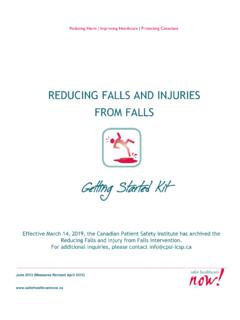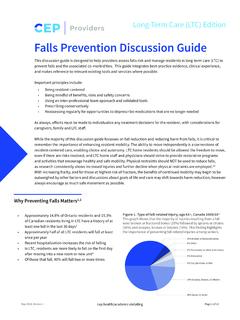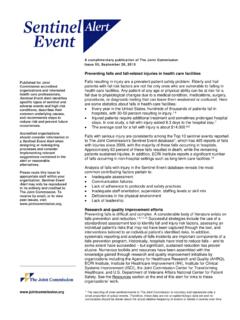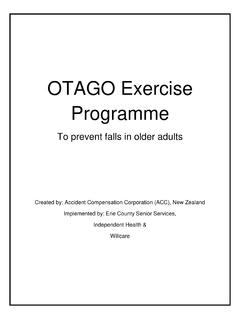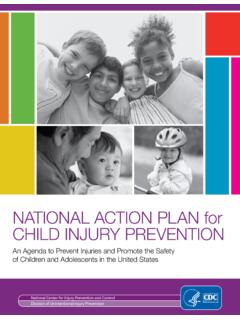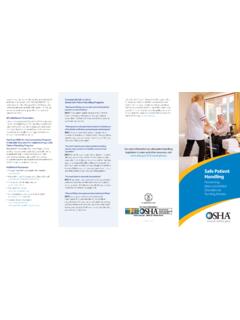Transcription of Falls Prevention Interventions in the Medicare Population
1 EVIDENCE REPORT AND EVIDENCE-BASEDRECOMMENDATIONSEVIDENCE REPORT AND EVIDENCE-BASEDRECOMMENDATIONSF alls Prevention Interventions in the Medicare PopulationFalls Prevention Interventions in the Medicare PopulationSanta MonicaLos AngelesSan DiegoSouthern CaliforniaSouthern CaliforniaEvidenceEvidence--BasedBasedPr actice Practice CenterCenterSanta MonicaLos AngelesSan DiegoPREPARED Department of Health and Human ServicesCenters for Medicare and Medicaid Services7500 Security Blvd. Baltimore, MD 21244-1850 PREPARED BY:RANDCONTRACT NUMBER:500-98-0281 CONTRACT PERIOD:September 30, 1998 to September 29, 2003iProject Staff Principal Investigator Paul Shekelle, , Project Manager Margaret Maglione, Article Screening/Review John Chang, , Walter Mojica, , Senior Statistician Sally C. Morton, Quantitative Analyst Marika J. Suttorp, Senior Programmer/Analyst Elizabeth A. Roth, Staff Assistant/ Database Manager Shannon Rhodes, Cost Analyst Shin-Yi Wu, Medical Editor Sydne Newberry, Principal Investigator Laurence Rubenstein, , Healthy Aging Project CMS Project Officer Pauline Lapin, ii TABLE OF CONTENTS EXECUTIVE SUMMARY.
2 IV 1 METHODS .. 3 IDENTIFICATION OF LITERATURE 6 EVALUATION OF POTENTIAL 13 EXTRACTION OF STUDY-LEVEL VARIABLES AND 15 STATISTICAL 24 COST 27 RESULTS .. 28 IDENTIFICATION OF 28 SELECTION OF STUDIES FOR THE META-REGRESSION 30 CONTROLLED TRIALS EXCLUDED FROM THE META-REGRESSION 35 RESPONSES TO QUESTIONS SPECIFIED BY CMS .. 42 LIMITATIONS .. 69 CONCLUSIONS .. 71 72 REFERENCES 73 ACCEPTED ARTICLES - Falls EVIDENCE 80 REJECTED ARTICLES - Falls EVIDENCE 86 EXPERT PANEL 118 EVIDENCE 119 iii TABLES TABLE 1. LITERATURE SEARCH TABLE 2. REVIEW AND BACKGROUND TABLE 3. FOLLOW-UP PERIODS FOR ARTICLES WITH Falls TABLE 4. STUDIES WITH MULTIPLE TIME POINT TABLE 5. STUDIES EXCLUDED FROM META-REGRESSION TABLE 6. RCT STUDIES INCLUDED IN META-REGRESSION TABLE 7. POOLED TABLE 8. META-REGRESSION ESTIMATES OF THE EFFECT OF INDIVIDUAL INTERVENTION TABLE 9. COMPONENTS OF A MULTIFACTORIAL Falls RISK TABLE 10.
3 EXERCISE TABLE 11. SETTING TABLE 12. COST EFFECTIVENESS TABLE 13. COST ANALYSIS BASE CASE TABLE 14. COST ANALYSIS SENSITIVITY ANALYSIS 1 ..63 TABLE 15. COST ANALYSIS SENSITIVITY ANALYSIS 2 ..63 TABLE 16. COST ANALYSIS SENSITIVITY ANALYSIS 3 ..64 TABLE 17. COST ANALYSIS SENSITIVITY ANALYSIS 4 ..64 TABLE 18. COST ANALYSIS SENSITIVITY ANALYSIS 5 ..64 TABLE 19. INTERVENTION BY Population TABLE 20. REFUSAL RATE OF PERSONS ELIGIBLE TO PARTICIPATE IN RANDOMIZED CLINICAL TRIALS OF Falls Prevention FIGURES FIGURE 1. CONCEPTUAL FIGURE 2. Falls Prevention ARTICLE SCREENING FIGURE 3. Falls Prevention ARTICLE QUALITY REVIEW FIGURE 4. ARTICLE FIGURE 5. SHRINKAGE PLOT OF CLINICAL TRIALS OF Falls Prevention Interventions ASSESSING THE OUTCOME "SUBJECTS WHO FELL AT LEAST ONCE" ..42 FIGURE 6. SHRINKAGE PLOT OF CLINICAL TRIALS OF Falls Prevention Interventions ASSESSING THE OUTCOME "MONTHLY RATE OF FALLING"44 FIGURE 7.
4 FUNNEL PLOT OF STUDIES ASSESSING RISK OF FALLING AT LEAST FIGURE 8. FUNNEL PLOT OF STUDIES ASSESSING RATE OF iv EXECUTIVE SUMMARY Introduction Falls are a major health problem among older adults in the United States. One of every three people over the age of 65 years living in the community Falls each year, and this proportion increases to one in two by the age of 80 fall -related injuries in older adults often reduce mobility and independence, and are often serious enough to result in a hospitalization and an increased risk of premature among older persons in the community have found that about 10 percent of the fallers have a serious fall -related injury, including fractures, joint dislocations, or severe head Falling has also been found to be associated with subsequent admission to a nursing costs of health care associated with fall -related injuries and fractures, including hip fractures, are staggering.
5 The total direct cost of all fall injuries in older adults in 1994 was $ billion and is estimated to reach $ billion by costs for hip fractures were estimated in 1991 to be $ With an aging Population and a growing number of hip fractures, these cost estimates are projected to rise to as high as $240 billion by the year Clearly, the Prevention of Falls is an important issue if it can prevent significant declines in function and independence, and the associated increase in costs of complications. The major risk factors for falling are diverse, and many of them--such as balance impairment, muscle weakness, polypharmacy, and environmental hazards-- are potentially , the Interventions designed to address these risk factors share the same diversity. Likewise, the evidence for the effectiveness of a single intervention in preventing Falls has been Since the risk of falling appears to increase with the number of risk factors,3multifactorial Interventions have been suggested as the most effective strategy to reduce falling.
6 Heretofore, numerous Interventions have been studied in the Prevention of Falls . Results have been mixed, yielding uncertainty as to which Interventions are most clinically effective or cost-effective, or what kind or combination of Interventions should be included in a program to prevent Falls . To gain a better understanding of which Interventions may be beneficial in the Medicare Population , the Centers for Medicare and Medicaid Services (CMS), as part of its Healthy Aging Project, commissioned an evidence-based systematic review of Interventions in the Prevention of Falls , the results of which are detailed in this report. For this report, CMS asked us to provide evidence in response to the following questions: 1. Are Falls Prevention programs effective? What are the key components that should be included in a Falls Prevention intervention? Are multifactorial vapproaches more effective than single intervention approaches?
7 2. Are public information or education campaigns alone effective in reducing or preventing Falls ? 3. Which care settings/approaches have been more effective than others for the delivery of Falls Prevention Interventions ? Which providers should deliver this service? 4. What are the key issues in sustaining Falls Prevention programs? 5. Cost effectiveness or cost savings Do Falls Prevention Interventions appear to reduce health care costs by reducing disease, physician office visits, hospitalizations, nursing home admissions, 6. Should Falls Prevention programs be targeted toward high-risk individuals? Are there a few basic questions to identify these individuals? Can this be done through self-identification? 7. Are there specific Falls Prevention exercises recommended for seniors? 8. Are Falls Prevention programs acceptable to seniors? Methods For our systematic review, we classified intervention components that can be used to prevent Falls among persons age 65 or older into the following broad categories: Exercise:General Physical Activity.
8 Includes non-physiotherapy activity -- for example walking, cycling, aerobic movements, and other endurance exercises. Specific Physical Activity. Includes training geared specifically towards balance, strength, or gait. Multifactorial Falls risk assessment and management can include a focused post- fall assessment or a systematic risk-factor screening among at-risk individuals tied to Interventions and follow-up for the risks uncovered. A multifactorial Falls risk assessment and management program consists of three components: 1) a questionnaire to identify risk factors for Falls , which can be self-administered or administered by a professional; 2) a thorough medical evaluation (including examination of vision, gait, balance, strength, postural vital signs, medication review, cognitive and functional status); and 3) follow-up Interventions , that may include a tailored exercise program, environmental modifications, and assistive devices.
9 Education. Educational efforts can be directed toward an individual, group, or entire community. Pamphlets and posters can raise awareness among older adults or staff members at senior centers and nursing homes. More intense Interventions include one-to-one counseling about risk factors. Assistive Devices. These include canes and walkers. Medication / Medication Review. This category includes two approaches. First, physicians can review patient records to evaluate whether side effects of any medication vi may contribute to Falls . Second, hormone replacement therapy, calcium, and vitamin D can be used to increase muscle or bone strength in an effort to prevent Falls . Environmental Modification. Environmental modification often includes home visits to older adults living in the community. Professionals examine the environment for hazards such as poor lighting, sliding carpets, and slippery floors. Recommended modifications include installing grab bars, placing bath mats in the shower, and keeping a working flashlight at home.
10 Staff / Organization Related. These Interventions most often take place in hospitals and nursing homes. A Falls - Prevention specialist may visit a facility and make recommendations, including patient-reminder bracelets, bed alarms, and restraints. In addition to conducting an extensive library search, we used literature from RAND's Assessing the Care of Vulnerable Elders (ACOVE) project, the Cochrane Collaboration, the American Physical Therapy Association (APTA), CMS, and the American Geriatrics Society (AGS) Falls Guidelines Taskforce. When articles arrived, we reviewed each reference list in order to find additional relevant literature. We reviewed the articles retrieved from the literature searches against exclusion criteria to determine whether to include articles in the evidence synthesis. To be accepted for inclusion, a study had to be either a randomized controlled trial (RCT) or a controlled clinical trial (CCT).










